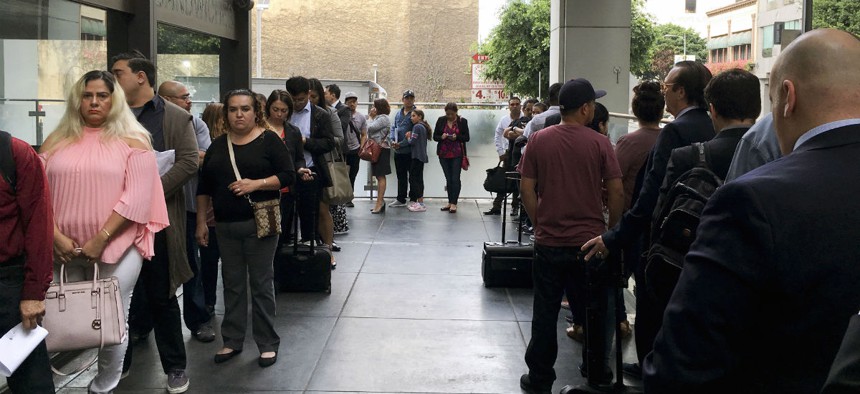Nine Major Agency Reform Proposals in Trump's 2020 Budget
Hiring surges, eliminated offices and more in the White House's latest budget blueprint.
President Trump’s fiscal 2020 budget called for drastic cuts at most federal agencies, reductions that would significantly reorient the work many federal employees do.
The president would outright eliminate many offices and programs, while reprioritizing and restructuring work at a slew of agencies. In some cases, Trump proposed new agencies or called on existing departments to beef up their workforces. Many of the proposals are new, while others have repeatedly been rejected by Congress. In most cases, the details of the recommendations were obscured by the administration’s decision to withhold all the details of the budget until next week.
Here is a look at some of the most significant reform proposals in the new budget blueprint:
- Reprioritizing federal work: The Trump administration plans to refocus agencies across government to ensure they steer their employees away from “low-value work.” The Office of Management and Budget is coordinating these efforts with the General Services Administration and Office of Personnel Management, which will continue to reform “burdensome data collection and reporting requirements.” Trump also budgeted for agencies to hire “evaluation officers” to bolster evidence-based policymaking.
- Census ramp up: The Census Bureau is requesting $7.2 billion as it gears up for deployment of the decennial count, a funding infusion that would nearly double its current allocation. The increase roughly matches the funding allocation the bureau received in 2010 as it prepared for the last count.
- Homeland Security hiring: As he has in each of his budget proposals, Trump continued to ask for a hiring surge at the Homeland Security Department. At Customs and Border Protection, the Border Patrol would see funding for 750 new agents, matching its fiscal 2019 request. While the agency hired more new employees in fiscal 2018 than it lost to retirement or other employers, it boosted its rolls by just over 100 positions and still has thousands of vacancies. Trump also requested 171 new customs officers and additional support staff. Immigration and Customs Enforcement requested funding for 1,000 new agents, down from the 2,000 agents it asked for last year. Both CBP and ICE have struggled to reach Trump’s mandated hiring, which Congress noted in a hearing last week and by repeatedly declining to fund the hires for several years. ICE would receive an additional 538 support staff and 128 prosecuting attorneys, while the Secret Service would see an additional 177 agents and staff.
- Other hiring: The Justice Department’s Executive Office of Immigration Review requested funding for 100 new judge teams. That came just a few days after EOIR told Congress it had to freeze hiring that Congress has already funded due to unforeseen costs. The Labor Department would seek to boost staffing in its Office of Labor Management Standards to investigate misconduct inside labor unions. OLMS’s investigative workforce has dropped by 40 percent over the last decade, the White House said.
- Staffing cuts: As in previous years, Trump proposed massive budget reductions at most federal agencies, most of which would result in staffing cuts. The White House highlighted a couple of its top priorities. The Defense Department would continue to slash its headquarters workforce, which, coupled with other efforts to reduce “management overhead," the White House said would save $6 billion in fiscal 2019. The Health and Human Services Department plans to trim its Public Health Service Commissioned Corps to make it “leaner” and “more efficient.” Expect to see proposed workforce cuts at the Environmental Protection Agency, State Department and several other agencies when the full budget details emerge next week.
- Eliminating offices and programs: As he has also pitched in the past, Trump suggested doing away with dozens of programs and offices altogether. The Commerce Department would eliminate its Economic Development Administration, while the Education Department would do away with 29 programs it deemed ineffective, duplicative or unnecessary, for a projected savings of $6.7 billion. The Energy Department would eliminate several offices, including divesting its power marketing administrations. The Housing and Urban Development Department would zero out its block grant programs, such as the Community Development Block Grant. The Labor Department would consolidate the 40 workforce development programs across government, while the Environmental Protection Agency would end many of its “voluntary and lower-priority activities.”
- Interior Department reorganization: Interior plans to move much of its workforce out of Washington, D.C., and into western states to bring employees closer to the land and resources they manage. It is also moving forward on realigning the department’s regional structure into 12 new boundaries. The administration promised additional details would be released next week about the “phased implementation” of its governmentwide reorganization plan.
- Veterans Affairs Department reforms: VA requested $8 billion for its implementation of the Mission Act, which will consolidate existing programs giving veterans access to private health care. It also seeks to boost funding for its new Office of Accountability and Whistleblower Protection by 25 percent, which the department said has helped it “more efficiently discipline” its employees.
- Space: Trump budgeted for a new branch of the military, to be housed under the Air Force, to ramp up the military’s presence in space. NASA would also see a budget increase to hasten lunar exploration goals. The administration plans to first send cargo to the moon’s surface, followed by astronauts.








